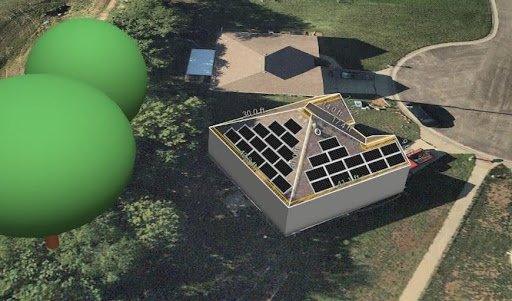Designing and installing solar energy systems is a complex process, but one that can have a large impact on the effectiveness of your solar panels. A solar panel system must be designed to take into account many factors, including the area and structure of the surface they are being installed on, energy needs, sun angles, location, local regulations, and much more. Getting the solar design and installation process right the first time takes years of experience.
At Cromwell Solar, we bring more than four decades of solar installation know-how to every job, and work with trusted installers using top quality Tier One solar equipment. We have the experience and personnel to design and install solar throughout Kansas and Missouri.
Factors Affecting the Solar Design Process
The proper installation of solar panels is even more important than other construction projects as, if properly installed, a solar project will last for 40 years. As time goes by, the difference between a great and a just-OK-quality solar panel installation will become more apparent. Safety is also a huge concern for solar installations as working with electricity and working at heights are two of the most dangerous construction tasks.
Most residential roofs in Missouri and Kansas are pitched and typically made of either asphalt composition shingles or metal, while many commercial roofs in our area are flat. Solar panel installation techniques vary between roof types, but some things are consistent no matter the roof angle or material.
In general, whether a large commercial solar project or a small residential project with a few panels, the solar design and installation process includes:
Initial assessment and solar system modeling
Final solar design blueprint creation
Permits and permissions
Installation of solar racking and solar panels
Monitoring setup
Final inspections and solar system activation/commissioning
Initial Assessment and Modeling
Every solar panel installation project begins with the design process. This phase is when the electrical needs of the building, the available roof space, and the owner’s goals and budget are combined into a proposed solution for a project.
Cromwell Solar analyzes electric bills and reviews satellite images of the roof to build potential solar solutions unique to each project, whether commercial or residential. Advanced computer modeling software is used to determine the estimated energy output for each solar panel in a project. Our solar system modeling takes into account the location of the project, area weather (using the closest of the 30,000 weather stations across the US), the pitch (angle) and orientation (what direction it faces) of the panel, and potential shading from nearby trees and other obstacles. We combine the energy output of all the solar panels and factor in utility rates and solar rules (such as net metering) to determine energy savings.
A mockup of a solar design from Cromwell Solar.
Home solar output modeling
Trustworthy modeling of solar panel output and energy savings is complex, but can be accomplished with the right tools and expertise. Careful modeling will take into account the unique solar rules for the area of the installation and the utility rate structure for solar projects.
In Kansas and Missouri there are over 100 completely separate utility companies all with their own rules and utility rates for solar projects. Proper modeling is essential to give a client a realistic expectation of the financial advantages of installing solar on their specific building with their specific utility rate structure. If a solar company does not have the experience or ethics, the modeling will not reflect reality. Cromwell Solar takes an engineering approach to solar panel modeling grounded in validated practices and time-tested use cases, and has worked with over 100 separate utilities across Kansas and Missouri to complete solar panel installation projects.
Final solar panel system design and project blueprints
Once an initial design is checked and approved by a client, we create project blueprints for a solar installation project. In the past few decades the requirements for solar designs has greatly increased — today, most jurisdictions require full blueprints and, particularly for commercial projects, engineering stamps.
The added complexity, coupled with cheap and easy AI and off-shore solar design services, has led most solar installation firms to outsource all of their solar designs. Unfortunately, when a solar installation firm has no designers in-house they lose the ability to understand the complexities of an installation and lose their ability to adapt to challenges that come up during solar panel installation. In contrast, Cromwell Solar has increased our in-house solar design capabilities and completes electrical and structural engineering on all our residential and commercial projects. We do this whether required by local code or not as this extra step ensures that our solar projects are safe.
Designing solar panel systems to withstand extreme weather
In Kansas and Missouri, solar projects should be designed with careful attention to the potential extremes of our Midwestern weather. High winds mean it is often best to design solar projects in Missouri and Kansas that can handle wind speeds beyond what the code book might say. For instance, some areas might not even have a specific wind load requirement for solar but our long experience in the Midwest means we know high winds are possible in most places.. An outsourced solar design process could deliver perfectly legal solar designs that fail to account for our Kansas and Missouri storms.
At Cromwell Solar we have a team of licensed solar design professionals who all have hands-on solar installation experience with us. All of Cromwell’s solar projects are carefully designed to meet the most stringent solar installation standards anywhere, even if located in an area without any standards at all.
Solar permits and permissions
Once a solar panel system design is in place, permits and utility interconnection agreements are needed before we can proceed with a project. The process of obtaining permission to install and interconnect solar panels to the grid is usually the lengthiest portion of going solar. For most residential solar projects in Kansas or Missouri the utilities have (and take) 30 days to evaluate a solar plan. Commercial solar projects in Missouri and Kansas can take the utilities up to 90 days for approval.
Various cities and counties have their own permit process that a reputable solar installer must follow to avoid future issues. In extreme cases unpermitted solar projects have had to be uninstalled if proper permissions were not obtained ahead of time. A good solar installation firm like Cromwell will handle all of the required paperwork for your project, ensuring your solar panel system meets all applicable rules and regulations. We only need a few signatures from you to get started, and will keep you informed of progress throughout the process.
With solar designs, permits, and permissions in place the solar installation process can begin!


